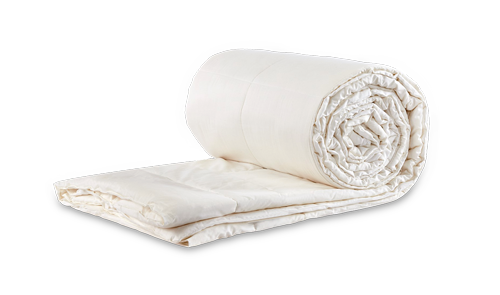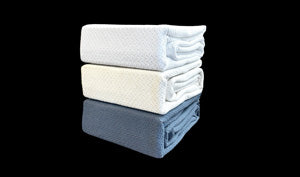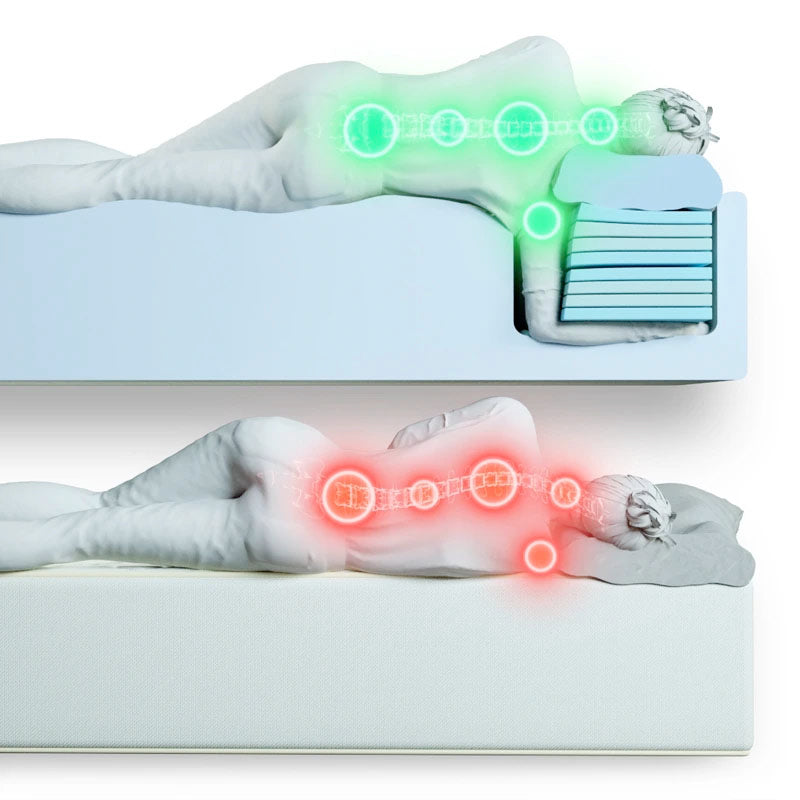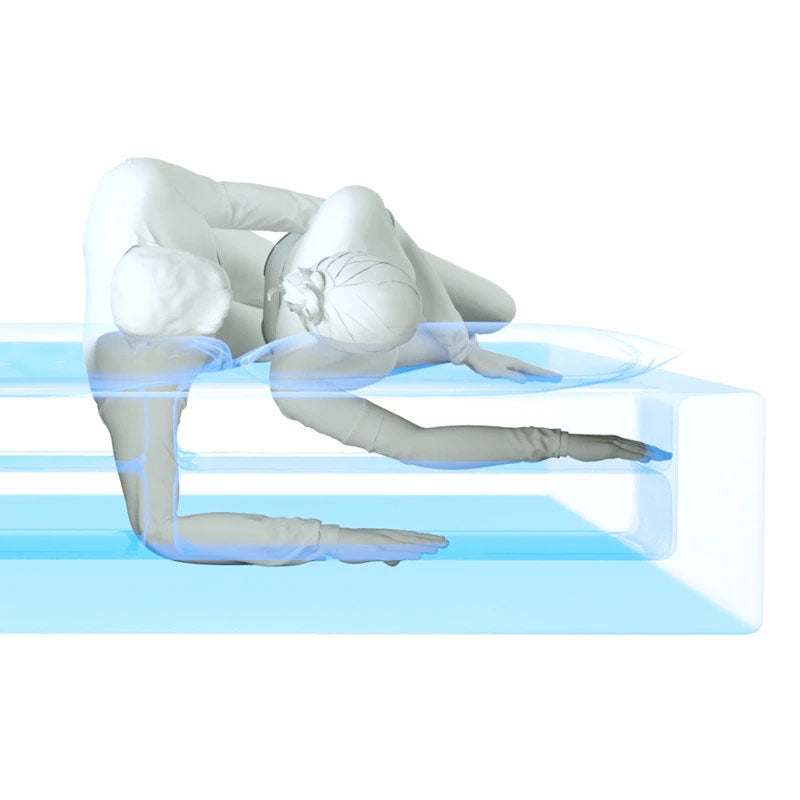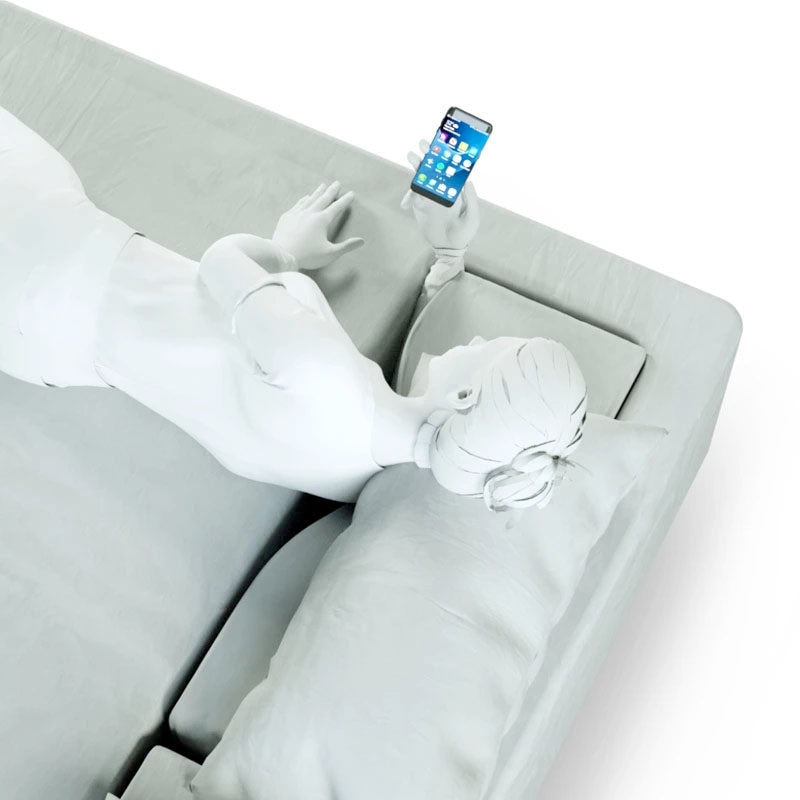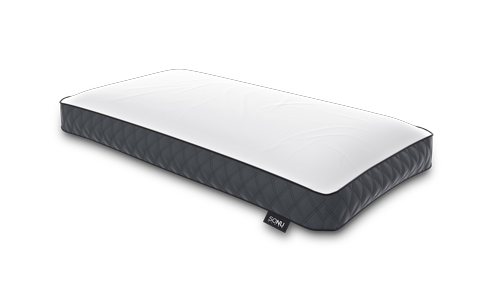When it comes to mattresses, you should be picky. If you are someone who sleeps on their side, you deserve a mattress that caters to your sleep position. And if you are a side sleeper who suffers from shoulder pain, you may need to do a little extra research to find the best mattress.
That’s where SONU Sleep comes in. With negative space technology, the SONU Sleep System was made to reduce shoulder pain and uncomfortable pressures that are unavoidable with all other mattresses.
Whether you’re on a budget or don’t mind spending extra money on a quality mattress, we’ve sorted through the different mattress types available, so you don’t have to. However, before we jump into that list, let’s look at what might be causing your shoulder pain.
What Are the Most Common Causes of Shoulder Pain?
People experience shoulder pain for a variety of reasons, like an injury, medical condition, or overuse. Let’s look at a few of the most common causes of shoulder pain.
Bursitis
Bursitis occurs when the bursae, fluid-filled sacs surrounding the joints, become inflamed. Bursitis occurs most often in the shoulders, elbows, hips, and knees. If your joints are swollen and red, achy or stiff, or hurt to the touch, you may be experiencing symptoms of bursitis. Call a doctor if a fever accompanies your pain or you cannot move your joints.
What causes bursitis? Repetitive motions and putting excess pressure on joints can cause it. Older people, people with physical occupations or hobbies, or people with chronic medical conditions like diabetes are more prone to bursitis than others.
You can prevent bursitis by warming up before engaging in physical activity, taking part in regular exercise, using kneeling pads, taking regularly scheduled breaks, and maintaining a healthy weight.
Osteoarthritis
Osteoarthritis develops when the protective cartilage at the ends of your bones wears down. It is the most common form of arthritis. It most frequently affects the knees, hips, hands, and spine. The damage from osteoarthritis can not be reversed, but there are ways to minimize your pain.
Signs of osteoarthritis include pain, stiffness, loss of flexibility, and a grating sensation in the joints. Some sufferers experience bone spurs and swelling. If any of these symptoms become persistent, it is time to consult a doctor.
Women, older people, and obese people are more susceptible to osteoarthritis. Some people are genetically predisposed to osteoarthritis.
Rheumatoid Arthritis
Rheumatoid arthritis is an inflammatory disorder in which your immune system attacks your body’s tissues. This form of arthritis can affect the eyes, skin, heart, kidneys, lungs, bone marrow, blood vessels, and other parts of the body. Many people experience the disease in their knees, ankles, wrists, elbows, hips, and shoulders.
Symptoms of rheumatoid arthritis include fever, loss of appetite, chronic fatigue, joint stiffness, and tender, swollen joints. See a doctor if you notice consistent swelling of the joints. People of any age can develop rheumatoid arthritis. Women are more likely to have it than men. Excess weight and smoking increase your chances of having rheumatoid arthritis.
Rotator Cuff Injury
The rotator cuff consists of tendons and muscles surrounding the shoulder joint. It is commonly injured when people perform repetitive overhead motions, like raising the shoulder while painting. An ache in the shoulder is a sign that the rotator cuff may be injured.
Physical therapy helps people manage rotator cuff injuries. A physical therapist will instruct a person with this injury to do exercises that increase the strength and flexibility of muscles around the shoulder joint. Someone with an injured rotator cuff may have difficulty sleeping due to the pain, have a hard time raising their arm when combing their hair, or may experience weakness in their arm. You should contact a doctor if you experience weakness.
Those at greater risk for rotator cuff injuries include construction workers, athletes, and people over 60. Not treating the injury can result in permanent loss of movement in the shoulder. The connective tissue in the shoulder can become denser over time, creating what’s known as a frozen shoulder.
Tendinitis
Tendinitis occurs when tendons become irritated or inflamed. Tendons are the cords that connect muscles to bones. This injury occurs most often in the heels, knees, wrists, elbows, and shoulders.
Tendinitis has many other names. These names include:
- Jumper’s knee
- Tennis elbow
- Pitcher’s shoulder
- Golfer’s elbow
- Swimmer’s shoulder
Rest is usually enough to cure tendinitis. In some cases, you may need pain medication or physical therapy. Symptoms of tendinitis are mild swelling, tenderness in the joints, and aches in the joint. See a doctor if rest does not help relieve pain from tendinitis.
Athletes who play baseball, golf, basketball, and tennis often experience tendinitis. Anyone whose job involves repetitive movements is at risk for tendinitis.
What Are the Treatment Options for Shoulder Pain?
We are not medical professionals. The following advice is what we found after doing research on the topic of shoulder pain. For more personalized advice, you should always consult your doctor. That said, let’s get to it.
Change Your Mattress
If you’re experiencing shoulder pain while you sleep on your side, the first thing we’re going to suggest is that you check your mattress. Does it conform to your body? How long has it been since you changed it?
According to studies, many people experienced relief from shoulder pain by selecting better bed systems. Participants reported decreased pain and stiffness in their necks, backs, and shoulders after switching to new mattresses.
The SONU Sleep System is made with a patented Comfort Channel that allows you to immerse your shoulder into the mattress itself, paving the way for full range of motion even when you are in bed. Your new SONU mattress comes with Support Pillows for the ultimate comfort and support for your head, arms, and shoulders.
See a Physical Therapist
Seeing a physical therapist for shoulder pain can be life-changing. A physical therapist can show you new ways to maneuver your shoulder that will alleviate your pain issues. Physical therapy can involve a variety of tactics.
Your therapist may apply heat or ice to your shoulder, or may help you perform stretches or resistance exercises that improve rotator cuff movement. The duration of your physical therapy program may depend on the severity of your injury or pain, and some patients decide to regularly attend sessions.
Avoid Certain Activities
You may have to quit the activities that made your shoulder pain flare-up in some instances. For rotator cuff injuries, for example, avoiding overhead activities is known to help. Modifying the exercises you do when you work out can help. Avoid activities that involve a lot of shoulder movement, like kayaking, overhand throwing, or bench pressing. If you play sports that involve the shoulders, like golf, you will need to change your range of motion so that your shoulder isn’t injured further.
Try Medication
If modifying your activity and physical therapy do not help, a doctor might advise you to take pain medication such as aspirin, acetaminophen, or nonsteroidal anti-inflammatory drugs (NSAIDs).
Alternatively, they may prescribe you something stronger than an over-the-counter pain reliever. In some cases, your doctor may refer you to a pain specialist who may administer painkillers via injection. The most common injections are cortisone shots, which target inflammation in the joints. A medical professional may administer a local anesthetic before injecting you.
Surgery
Surgery is usually the last resort for treating shoulder pain. After exhausting all of your options, the only thing left to do may be to have surgery. Patients who experience debilitating pain that is unresponsive to other treatments are likely to be referred for surgery.
Rest
Last but certainly not least, shoulder pain can be treated with rest. Sometimes, you need to take a temporary break from the activities that are causing your shoulder to hurt. Your doctor may recommend that you take a few days or weeks off from activities to recover.
Enjoy this time off and reflect on whether you are overusing your shoulder and if there are ways that you can complete your favorite activities without hurting yourself.
How Is Sleep Important for Pain?
Sleep is one of our biological needs. It affects our mental and physical health, and it can make our pain better or worse.
Sleep and pain affect each other. Being in pain can keep you up at night. Getting inadequate rest because of your pain can affect your cognitive abilities. Have you ever been too tired to think straight? That can happen if your pain is disrupting your sleep.
You have to find a way to get some sleep despite your pain. A doctor might prescribe you a pain medication that will also help you sleep. If you’re a chronic pain sufferer, getting a good night’s sleep can reduce stress, anxiety, depression, and other emotions that make the pain worse.
How Does Sleep Position Factor In?
Our bodies experience a lot of stress throughout the day. Whether you work on your feet or sit at a desk, your ligaments, joints, and muscles work overtime. Staying in the same position for a long time is hard on the body, but constant, repetitive movement can be just as bad. To recoup, you need to sleep comfortably at night.
If you sleep in an uncomfortable position, your body can’t recover from a day’s work. Some positions put more tension on your body than others, resulting in aches and pains. Who needs that?
As you age, your sleep position becomes more important. The cartilage around your joints decreases, and you start to hurt in places you never imagined you’d experience any pain. Your best weapon is to sleep in a neutral position that allows your body to truly rest and rejuvenate.
What Are the Benefits of Side Sleeping?
Sixty percent of adults are side sleepers. That’s a lot!
Not only is sleeping on your side popular, but it’s also incredibly healthy. Side sleeping may have a variety of benefits spanning from reduced snoring and improved breathing to digestive support and cognitive function
Back Pain
If you’ve experienced back pain, try sleeping on your side. According to the Sleep Foundation, people who switch to a side sleep position report some relief from their back pain.
Air Flow
When you sleep on your side, your airway stays open, making it easier for you to breathe. This opening of the airway is great for people who suffer from sleep apnea.
Sleeping on your side can also help reduce snoring. Snoring is caused by the soft palate in your mouth and your tongue collapsing to the back of your throat, causing a vibrating sound. This is less likely to happen when you sleep on your side.
Digestion
How does sleeping on your side benefit your gut? People who sleep on their side experience more relief from gastrointestinal issues, constipation, bloating, and heartburn. These issues are often worsened when a person sleeps on their back.
Cognitive Function
Our brains get rid of waste 24/7, but much of this process occurs during sleep. While we sleep, our bodies work hard to restore and repair themselves, and sleeping on your side may help the brain remove waste faster.
The thoracic duct on the left side of your body is your primary lymph vessel, and the lymphatic system is the body’s method of waste and toxin removal. Lying on your left side specifically may make it easier for your thoracic duct to drain.
Pregnancy
When pregnant women sleep on their sides, they experience better blood circulation from their heart to their limbs, fetus, kidneys, and uterus.
What Are the Disadvantages of Side Sleeping?
As much as we love sleeping on our sides, it can present some issues, with pain or discomfort being the most common.
Sleeping on your side can put too much pressure on your shoulders and hips, which ends up causing you pain. Side sleep can cause the hips to twist during sleep, leading to aches and pains in the morning. The best way to prevent the hips from twisting during sleep is to put a pillow between your knees.
Some people may also wake up with a “pins and needles” feeling on their side after sleeping. This happens because sleeping on your arms disrupts circulation. You might wake up with the arm you slept on feeling numb or limp.
Side sleeping can increase your chances of getting wrinkles. It can also cause breasts to sag.
Sometimes, the position isn’t to blame; the mattress is. If you’re sleeping on a stiff mattress on your side, you may as well be sleeping on the floor. You’ll get the same result: pain.
Still looking to sleep on your side but want to avoid the possible adverse effects? SONU can help.
The SONU Sleep System is designed for side sleepers, and includes the patented Comfort Channel so you can fully immerse your arm and shoulder into the mattress for optimal range of motion and comfort. With SONU, you can enjoy less pressures on your body so you get a deeper, more restful night of sleep.
Which Side Is Best: Left or Right?
Believe it or not, which side you sleep on comes with different benefits. If you have acid reflux or heartburn, sleep on your left side. Heartburn and acid reflux occur more frequently in people who sleep on their right side.
However, if you’re at risk for heart failure, sleep on your right side. Sleeping on your left side or back when you have heart failure can cause discomfort.
If you are healthy, which side you sleep on doesn’t matter. Sleep on the side that feels the most comfortable.
What Is the Right Way To Sleep on Your Side?
If you’re a side sleeper who experiences some discomfort, you will find the next few tips very helpful.
Try Pillows
If you’re experiencing shoulder pain, avoid sleeping on that shoulder. With that shoulder facing up and your arm straight down, place a small pillow under your arm to reduce stress on your shoulder and elbow joints.
SONU’s Support Pillows are designed to go underneath your head pillow to offer better support for your arm and shoulder.
Twisting your torso while sleeping on your side can mean you’ll wake up with back and hip pain. To avoid this from happening, put a pillow between your knees. This will keep your upper leg from falling forward, and it will keep your spine aligned.
Chin Up
You want to maintain the natural curve of your neck when you sleep. Sometimes, side sleepers tend to tuck in their chins, putting the neck muscles in an unnatural position and stressing them. Keep your chin up and in a neutral position.
Place a pillow under your cheek that can support both your head and neck and keep them from drooping.
Alternate Sides
No one says you have to sleep on the same side all night long. Sleeping on the same side can cause imbalance; roll over and switch to the opposite side from time to time to prevent this.
Avoid the Fetal Position
Pulling your knees up towards your chest into the fetal position while you sleep may be comforting, but it puts unnecessary pressure on your back and neck, causing you pain.
How Can I Find the Right Mattress?
Alright, now that you know all the basics of sleeping on your side and different ways to treat shoulder pain, let’s get to the main event: finding the right mattress.
If you’re dead set on sleeping on your side and you suffer from shoulder pain, there’s a solution. Finding a mattress for side sleepers that suffer from shoulder pain isn’t as hard as it used to be.
Today, thanks to the wonders of the internet, you can find several types of mattresses that will help you get a good night’s sleep.
What Are Some Important Considerations?
Everyone wants a mattress that will allow them to get a full night’s sleep and wake up feeling rejuvenated. However, people have a range of preferences for their mattresses, such as material and firmness. If you’re someone with shoulder pain, you want the mattress that will give you the most relief.
A mattress that’s too soft won’t provide your body with enough support, and you’ll sink into it. A mattress that’s too firm won’t be flexible enough to mold to the curves of your body; it might even make the pain you’re trying to eliminate even worse.
You want to find a mattress that’s just right. It has just enough give with the exact amount of support you need, relieving your pain issues and aligning your spine.
A good mattress will offer you the following benefits:
- Motion isolation: How much movement the mattress absorbs.
- Temperature control: How ventilated a mattress is, helping it stay cool or retain warmth.
- Pressure relief: How a mattress conforms to the body.
- Off-gassing: An unpleasant odor that many mattresses have, and how quickly the smell disappears.
- Ease of movement: How easily a person can move on a mattress.
- Edge support: Measurement of how saggy a mattress will be when pressure is applied to the edge.
- Responsiveness: Measurement of bounce, noise, and temperature neutrality when people are on the mattress.
- Bodyweight: How much weight a mattress can support without sagging.
What Are Some Mattress Options for Side Sleepers with Shoulder Pain?
When searching for mattresses for side sleepers with shoulder pain, six types of mattresses consistently rose to the top of the results: innerspring, latex, foam, airbed, hybrid, and negative space.
What Qualities Should I Look For?
When testing mattresses for shoulder pain, consider the following factors:
Sleep Position
Side sleepers experience more shoulder and hip pain than people that sleep in other positions. To help with this pain, side sleepers should look for soft mattresses that contour to the body.
Contouring
The more a mattress contours to the body, the more pressure it relieves. The deeper the contour, the better the mattress feels for shoulder and hip pain sufferers. However, be mindful that sinking deep into the mattress may make you feel stuck.
Pressure Relief
Pressure relief is essential to relieving shoulder pain. Good pressure relief aligns the spine, reduces friction, and prevents similar aches and pains. When it comes to proper support and relief for your arm and shoulder, SONU’s mattress with an immersive Comfort Channel can help.
Firmness Level
Medium-firm mattresses are generally better for shoulder pain sufferers. However, you should choose the level of firmness that feels best to you. Standard firmness levels are soft, medium, firm, and extra firm.
Material Quality
Don’t skimp on quality in order to save money. Look for durable materials. They don’t have to be high-end, but they shouldn’t be something that’s easily damaged. Mattresses made of quality materials have to meet certain standards that guarantee their superior condition.
Noise Level
A squeaky mattress can quickly become annoying. A noisy mattress may not just wake you up at night–it could wake up other people in your household. Look for something that makes little to no noise when you get on and off of it.
Motion Isolation
The same way mattress noise can wake up someone sleeping next to you, so can motion. With a bed that offers good motion isolation, you or the person sleeping next to you will hardly feel you moving throughout the night.
Edge Support
We keep mentioning edge support because it’s important! No one wants to feel like they’re going to topple off the edge of the bed when they lay or sit on it. Some mattresses, like hybrid and latex, have more edge support than their foam counterparts.
Price
Price might be the first factor on your list. Who can blame you? The price of a mattress can make or break your decision to buy one. If you can’t afford that most popular mattress on the market right now, that doesn’t mean you can’t find something within your budget that works just as well.
Don’t go with the first mattress store you visit–shop around. Look for sales and coupons. Remember, ordering online tends to be cheaper than buying from a brick-and-mortar store.
What Types of Mattresses Should I Consider?
Side sleepers need mattresses that are firm enough to stop them from moving erratically in their sleep but soft enough to fit their bodies. Once you figure out the type of mattress that works best for your body, finding it and purchasing it will be the easy part.
Innerspring
Innerspring mattresses are made up of metal, coil-based systems. These mattresses have been around for decades, and they aren’t going anywhere anytime soon. They provide support, bounce, and temperature control, thanks to the air flowing between the coils. On their own, innerspring mattresses may not provide enough support for people in pain.
Therefore, you will commonly find them being sold along with box springs as a total package. Innerspring mattresses cost less than those made of other materials. People often buy them and then purchase mattress foam and cotton toppers to go on top of them.
Latex
Manufacturers typically use natural latex to create latex mattresses, but synthetic materials are also used on occasion. Latex is made from rubber tree sap, and natural latex means it’s free of outside debris, like sand. Different layers of latex are put together to form the core system of a mattress. Latex mattresses are known for their cushioning around the shoulders that doesn’t make you feel like you’re sinking.
Foam
Foam mattresses are made of many layers. These layers might consist of memory foam and polyfoam, along with some surprising materials like cotton, wool, or latex. Foam beds provide more contouring support than other mattresses, hitting all of your pressure points. This makes it a popular choice for side sleepers with shoulder pain.
Airbed
Are you surprised to see this one listed as an option? Don’t be. You can adjust the air chambers inside airbeds to change their level of firmness. They contain an additional layer of material like foam or latex.
The ability to adjust the firmness is popular with pain sufferers because their pain can change from day to day. These days, the mattresses can be inflated or deflated by the click of a button – modern airbeds come with remotes or apps, giving customers an easy way to control them.
Hybrid
Hybrid mattresses are made of two components, such as innerspring and foam, latex, cotton, wool, or another material. Hybrid mattresses provide the same stability and bounce as an innerspring mattress with additional comfort and motion isolation. This combination of materials provides a balance that shoulder pain sufferers find comforting.
Negative Space
The negative space mattress offered at SONU features a Comfort Channel beneath a layered support pillow system.
This channel was made so that side sleepers can insert an arm from whichever side they are sleeping on, eliminating the pain of having to figure out where to put that arm when they sleep. The negative space greatly reduces pressure on the shoulder, helping the sleeper enjoy a blissful, one-of-a-kind sleep experience.
How Firm Should My Mattress Be?
We mentioned previously that medium firmness is most popular for side sleepers. However, there is no one-size-fits-all when it comes to mattress firmness. You can have two people sleeping in the same bed who have different preferences for how firm they want their side of the mattress to be. And luckily, they can find dual mattresses that accommodate that need!
The difference in mattress firmness levels can be extreme. Softer mattresses offer less support and usually have lower weight limits. So if you are a person of around 200 pounds and you like sleeping on your side, a soft mattress probably won’t be able to support you properly.
A mattress that is too firm can actually hurt you. They aren’t very forgiving for the neck and hips, and there will be a limited amount of responsiveness to the body.
So a mattress with medium firmness should hit the sweet spot between a soft mattress and a firm one. Remember that the firmness levels are on a scale of one to 10, so there are multiple sublevels to firmness rates.
Other Support for Side Sleepers
Still undecided? Maybe you want to budget for the mattress of your dreams, and that’s okay. In the meantime, there are other things you can do to help yourself if you are a side sleeper and experience shoulder pain.
There are countless side-sleeper pillows on the market that help take pressure off of the shoulders when you sleep. They are made of different materials, just like mattresses. You can enjoy a foam, latex, or cotton support pillow that contours to your neck and shoulders, providing an ergonomic sleep experience. The pillows come in different shapes and sizes.
Conclusion
Human beings may be the most innovative creatures on the planet. No matter what issues we have, we find ways to solve them. It’s not surprising that numerous experts have found ways to accommodate side sleepers who experience shoulder pain. Hopefully, this article has helped you realize that you are not alone in your pain and that there are several ways to improve your sleep and eliminate your pain.
FAQ
Could my mattress be causing my shoulder pain?
Yes. If you are sleeping on a mattress that can’t handle your body weight and feels uncomfortable to sleep on, it can be the cause of your shoulder pain. Take note of when you feel the pain – does it happen every time you lie on your side on this mattress? How old is this mattress? Sleeping on an old and worn down mattress can also cause you pain.
How does a mattress cause shoulder pain?
We spend a lot of time in bed. Lying on your shoulder for a prolonged period on the wrong mattress can lead to shoulder pain. This may be because the mattress has little to no cushioning or is too firm. Side sleepers are prone to shoulder pain more so than other sleepers.
Do I have to buy a new mattress? Can’t I just purchase a mattress topper?
A mattress topper can be a temporary fix for your mattress issues. It can provide you with the extra cushioning or level of firmness you need to support your shoulder. Over time, the mattress topper will wear down, maybe even faster than a mattress would. So consider the long-term benefits of buying a mattress designed for shoulder sleepers as opposed to buying a temporary fix like a mattress topper.
Sources:
Shoulder pain Causes - Mayo Clinic
Bursitis - Symptoms and causes | Mayo Clinic
Osteoarthritis - Symptoms and causes | Mayo Clinic
Tendinitis - Symptoms and causes | Mayo Clinic
Chronic Shoulder Pain: Part II. Treatment | American Family Physician
Benefits and Which Side to Sleep On | Sleep Foundation
Best Pillows for Side Sleepers of 2022 | Sleep Foundation













